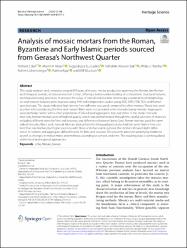| dc.contributor.author | Ball, Richard J. | |
| dc.contributor.author | Ansell, Martin P. | |
| dc.contributor.author | Su-Cadirci, Tuğçe Büşra | |
| dc.contributor.author | Baki, Vahiddin Alperen | |
| dc.contributor.author | Fletcher, Philip J. | |
| dc.contributor.author | Lichtenberger, Achim | |
| dc.contributor.author | Raja, Rubina | |
| dc.contributor.author | Wootton, Will | |
| dc.date.accessioned | 2024-08-19T11:01:54Z | |
| dc.date.available | 2024-08-19T11:01:54Z | |
| dc.date.issued | 2024 | en_US |
| dc.identifier.issn | 20507445 | |
| dc.identifier.uri | https://doi.org/10.1186/s40494-024-01277-3 | |
| dc.identifier.uri | https://hdl.handle.net/20.500.12573/2328 | |
| dc.description.abstract | This study analyses and compares around 650 years of mosaic mortar production spanning the Roman, late Roman and Umayyad periods, at Gerasa/Jerash in Jordan, offering a better understanding of composition, structural features, and manufacturing processes. It assesses the value of optical and electron microscopy examination of morphological and textural features, pore structure using MIP, and composition studies using EDX, XRD, FTIR, TGA, and Raman spectroscopy. The study indicated high density lime adhesive was used compared to other mortars. Wood was used as a fuel when producing the lime and natural fibres were incorporated when manufacturing mortars. Aggregates were primarily calcitic with a small proportion of silica-based aggregates. Key outcomes of the study conclude that early Roman mortars were of highest quality, which was demonstrated through the careful selection of materials including different stone for lime and tesserae, and differences between layers. Late Roman mortars used the same slaked lime plus fibres and charcoal. Mortars dating from the Umayyad period also had the same higher lime content than late Roman, but higher porosity with fibres and charcoal. In general, the mortars showed slight differences in content and aggregate; different stone for lime and tesserae. The research attests to underlying traditions as well as changes in mortar mixes and methods according to context and time. The resulting data is contextualized within local and regional approaches. | en_US |
| dc.description.sponsorship | Carlsberg Foundation, Danish National Research Foundation (DNRF119), Deutsche Forschungsgemeinschaft, Deutscher Palästina-Verein, H. P. Hjerl Hansens Fond for Palæstina Forskning, EliteForsk initiative of the Danish Ministry of Higher Education and Science, the H. P. Hjerl Hansens Mindefondet for Dansk Palæstinaforskning. | en_US |
| dc.language.iso | eng | en_US |
| dc.publisher | SPRINGER OPEN | en_US |
| dc.relation.isversionof | 10.1186/s40494-024-01277-3 | en_US |
| dc.rights | info:eu-repo/semantics/openAccess | en_US |
| dc.subject | Gerasa | en_US |
| dc.subject | Lime | en_US |
| dc.subject | Mosaic | en_US |
| dc.title | Analysis of mosaic mortars from the Roman, Byzantine and Early Islamic periods sourced from Gerasa’s Northwest Quarter | en_US |
| dc.type | article | en_US |
| dc.contributor.department | AGÜ, Mimarlık Fakültesi, Mimarlık Bölümü | en_US |
| dc.contributor.authorID | 0000-0001-6617-0924 | en_US |
| dc.contributor.institutionauthor | Su-Cadirci, Tuğçe Büşra | |
| dc.identifier.volume | 12 | en_US |
| dc.identifier.issue | 1 | en_US |
| dc.identifier.startpage | 1 | en_US |
| dc.identifier.endpage | 22 | en_US |
| dc.relation.journal | Heritage Science | en_US |
| dc.relation.publicationcategory | Makale - Uluslararası Hakemli Dergi - Kurum Öğretim Elemanı | en_US |


















